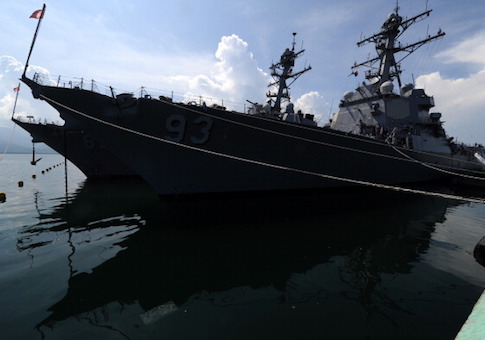The Navy conducted the latest freedom of navigation operation in the contested South China Sea on Monday, sending two guided missile destroyers near the Spratly Islands.
"The guided missile destroyers USS Preble and USS Chung Hoon conducted a freedom of navigation operation in the South China Sea May 6," said Lt. Cmdr. Tim Gorman, a spokesman for the Pacific Fleet.
"Preble and Chung Hoon sailed within 12 nautical miles of the Gaven and Johnson Reefs in order to challenge excessive maritime claims and preserve access to the waterways as governed by international law."
China denounced the warship passage, stating that Chinese warships and aircraft were dispatched to warn the Navy ships to leave the area.
Gaven Reef, according to satellite photos taken in November 2017, included a multi-story Chinese administrative building, gun emplacements, radar domes, wind turbines, and sensor communications equipment. Johnson Reef also has a multi-story building, a point defense gun emplacement, radar and communications equipment, and several observation towers. All were built within the past five years.
The warship passage came five days after Acting Defense Secretary Patrick Shanahan issued a stern warning to Congress on what he termed "the China threat," including efforts to take over the South China Sea.
"Make no mistake—China is extending that reach [in the Indo-Pacific] by increasing its overt military and coercive activities vis-à-vis its neighbors," Shanahan said.
"China's increasingly provocative behavior in the Indo-Pacific, particularly the South China Sea (SCS), should concern us all," he said.
The acting defense chief also said China is interfering with freedom of navigation in the sea. "We do not have to use our imaginations," he said. "China habitually threatens this freedom, using both conventional military force projection and 'gray zone' or irregular warfare activities."
One example, he said, took place in September when Chinese military vessels sailed dangerously close to the guided-missile destroyer USS Decatur off the coast of the Spratly Islands. "China's force projection inside and outside the [South China Sea] disrespects and undermines our rules-based international order and threatens regional stability and security," Shanahan said.
Between 2013 and 2018 China increased air and sea incursions into the South China Sea by a factor of 12, Shanahan said. "Within those five years, it also increased deployments of offensive and defensive weapons systems to the [South China Sea] by the same order of magnitude."
Land reclamation of islands in what the United States regards as international waters included 3,200 acres of islands between 2013 and 2015. The Chinese also are building facilities within a self-proclaimed "Nine-Dash Line" covering most of the sea that in 2016 the Permanent Court of Arbitration in The Hague ruled had no legal basis.
"These constructed features are almost four times the size of Central Park in New York City and roughly five times the size of this Capitol Hill neighborhood," Shanahan told the House Appropriations defense subcommittee
"Imagine walking from this hearing room to the Marine Barracks at 8th and I over what used to be part of the Pacific Ocean."
The Pentagon's annual report on China's military power said that during 2018 China continued to militarize disputed islands in the sea with deployments of anti-ship cruise missiles, including YJ-12B missiles, and long-range surface-to-air missiles in the Spratlys. The deployment violated a 2015 pledge by Chinese President Xi Jinping who announced that "China does not intend to pursue militarization" of the Spratlys.
The report noted that China appeared to be seeking to protect its oil supply lines by trying to take over the sea. About 78 percent of China's oil imports and 16 percent of natural gas imports transited the South China Sea and the Strait of Malacca.
PLA Sr. Col. Li Huamin, a spokesman for the PLA Southern Theater Command, said on Monday that PLA ships and aircraft were sent to identify and verify the U.S. warships and "warned them to leave."
Li said the forces of the southern theater would remain on high alert and "take necessary measures to resolutely safeguard China's sovereignty and security, and maintain peace and stability in the South China Sea."
Gorman, the Pacific Fleet spokesman, declined to say whether the Navy ships encountered resistance from the PLA. No photos or videos of the operations were released.
"U.S. Forces operate in the Indo-Pacific region on a daily basis, including in the South China Sea," Gorman said. "All operations are designed in accordance with international law and demonstrate that the United States will fly, sail, and operate wherever international law allows. That is true in the South China Sea as in other places around the globe."
Gorman said freedom of navigation operations are "routine and regular" and are "not about any one country, nor are they about making political statements."
At the Chinese Foreign Ministry, another spokesman, Geng Shuang, also criticized the warship passage.
"The trespass of U.S. warships is a violation of China's sovereignty," Gen said. "It undermines peace, security, and good order in the relevant waters. China deplores and firmly opposes such moves."
The warship passage comes amid heightened U.S.-China tension over the trade dispute. President Trump on Friday warned that China is facing an additional $200 billion in tariffs that were put off earlier this year as trade talks dragged on.
U.S. officials have said China has reneged on some original agreements reached in the ongoing trade dispute.
